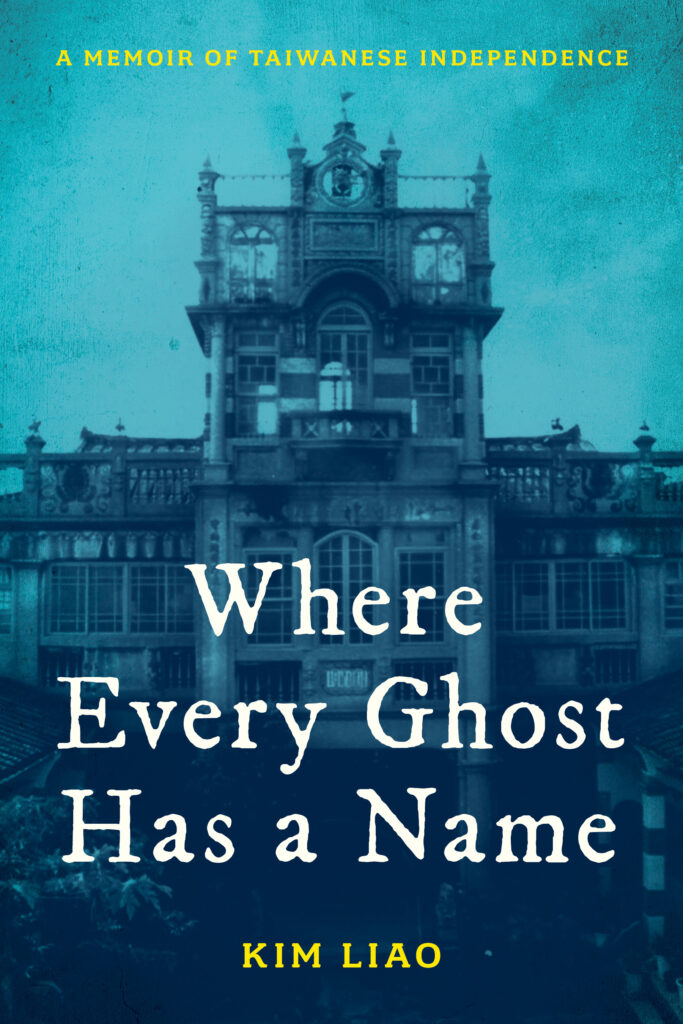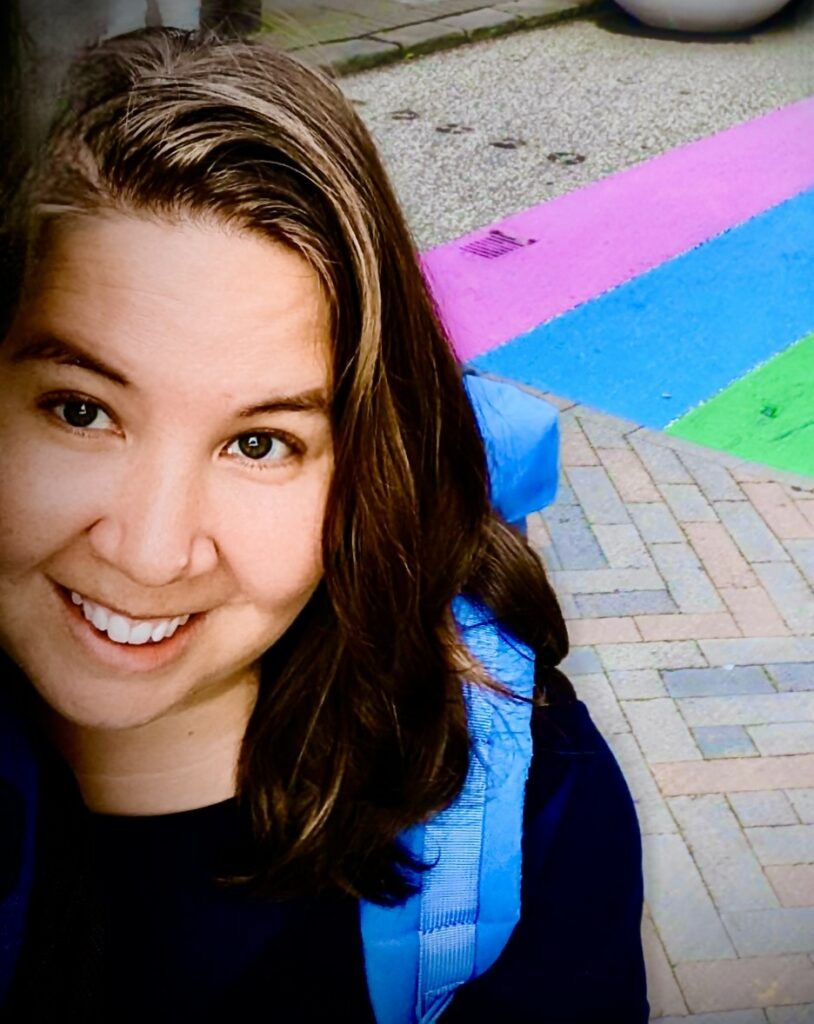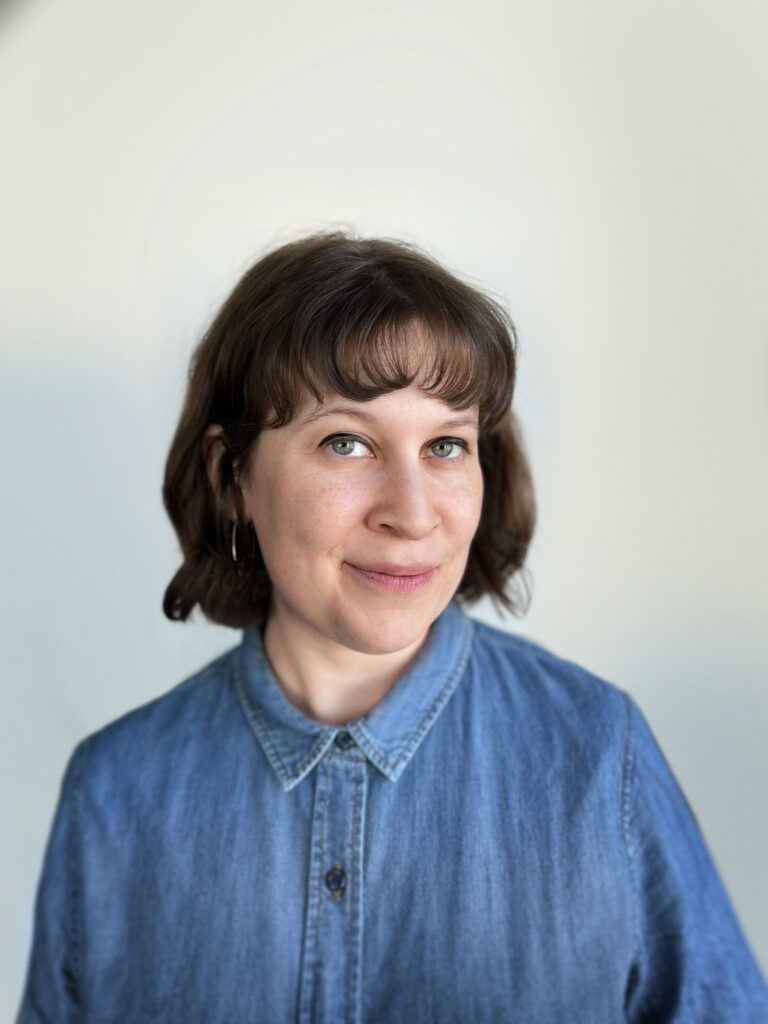Interview by Sarah Rosenthal
 In her debut memoir, Where Every Ghost Has a Name, Kim Liao travels to Taiwan in 2010, more than 60 years after her grandfather, Thomas Liao, the leader of the Taiwanese independence movement, was arrested by authorities there.
In her debut memoir, Where Every Ghost Has a Name, Kim Liao travels to Taiwan in 2010, more than 60 years after her grandfather, Thomas Liao, the leader of the Taiwanese independence movement, was arrested by authorities there.
Not long after Thomas Liao’s arrest, other members of the Liao family were arrested and had their land seized; but several family members, including the author’s grandmother, were forced into exile. Where Every Ghost Has a Name spans the year that Liao spent in Taiwan wading her way through her family’s history, which, she quickly learns, has been largely erased or hidden away by the KMT government. This historical and cultural silence around post-WWII Taiwan served as an uncanny mirror for the silence that surrounded the author’s own family after they arrived in the United States, lasting all the way into Liao’s adult life.
Liao expertly weaves memoir with narrative nonfiction, travel writing, family lore, and intensive historical research. The result is a story that illustrates the complicated impossibilities of truly understanding family stories, particularly ones entwined with political exile and trauma. I was drawn to Where Every Ghost Has a Name because it embodies what I love most in a work of creative nonfiction: narratives with a spine of truth, fleshed out by writing into the gaps of collective and individual memory as well as archival absence.
Liao’s writing has appeared in The New York Times, The Guardian, Electric Literature, Lit Hub, The Rumpus, McSweeney’s, The Millions, Salon, Fourth River, Hippocampus, and others. A former Taiwan Fulbright Creative Research Scholar, her work has received support from the Vermont Studio Center, the Jentel Foundation, the Hambidge Center, the Anderson Center, and the Ragdale Foundation. She lives with her family near New York City and teaches writing to students of all ages.
Like her writing in Where Every Ghost Has a Name, Liao was generous and thoughtful in our email-exchange interview earlier this month. Here is our conversation.

Sarah Rosenthal: Congratulations on the publication of Where Every Ghost Has a Name! I know this book was more than a decade in the making, and you mention that you had initially started writing about your work in Taiwan on your blog, Girl Meets Formosa. How did you navigate moving from blog writing to a book-length, heavily researched memoir? And how did you arrive at a braided book structure?
Kim Liao: Thanks so much for interviewing me, and that’s a great question about the genesis of this book. To contextualize the blog, this was 2010, the heyday of blogs, and there were so many blogs that became books that became movies — Julie and Julia [was] the success story that was at the forefront of my mind. So there was ambition there, but also a desire to write about my quest in Taiwan, and an interest in writing regularly and documenting the adventures I was having, as well as keeping in touch with friends and family. I say this because the tone of the blog, and its content, started very breezy, but also laid out my goals about learning about the history of the Taiwanese independence movement and my grandfather Thomas.
Over time, that tone shifted, and as I learned about really difficult moments in history, the blog started to reflect that. Some posts became the raw material that I used to craft chapters later in the book, or references later to remind me of how experiences felt. Also, my blog became an enormously helpful research tool, because scholars working on this time period were able to find me and share resources. The value of telling the internet that I was on a search for the truth about Thomas (Wen-Yi) Liao cannot be overstated, since so many kind strangers found me through my blog and offered assistance. I finally shuttered the blog recently with some real sadness, even though it has been dormant for over a decade. It was a proving ground where I got to try out my voice when writing about this subject.
Briefly, regarding the book structure, I think I always knew it would be a braided narrative. There was always going to be a story of the past and a story of the present. However, figuring out exactly where to start and end each narrative thread of the braid was very challenging, and considering how they’d intersect and what impression this interweaving would have for the reader was, in a word, tricky.
SR: The first chapter (brilliantly, in my opinion) begins with an anecdote about having learned the “wrong Chinese language” before arriving in Taiwan. Why did you decide to start with this particular anecdote?
KL: This kind of relates to my previous answer of not knowing exactly where to start for a very long time. I was torn between starting when I arrived in Taiwan, versus starting when I first became aware of my family’s mystery about Granda Thomas, versus starting when I decided to come to Taiwan after my father told me not to write about this (which is now in Chapter 2). Finally, I decided that the present day “Kim’s search” story would begin when I arrived in Taiwan, and set about conveying those earliest moments. And for me, the language barrier was the most enormous setback and inciting conflict. But also, I wanted there to be some humor and lightness because the story can get quite heavy.
SR: I was particularly moved by how you wrote from your grandmother Anna’s perspective at times, as well as other family members in addition to your own first-person perspective. What motivated you to include these perspectives? How did your research inform those sections?
KL: Several of my family members became point of view characters, since I wanted the book to read like a nonfictional novel. Most of those reconstructed history scenes were based on oral history interviews with my aunts and uncles, which I recorded and had transcribed, to try to get as many of the historical details right as possible. However, Grandma Anna and Grandpa Thomas are no longer with us, so making the leap in their psyches was an imaginative leap.
SR: Throughout the book, you wrestle with questions surrounding your family’s silence about Thomas Liao’s role in Taiwanese independence as well as a deep desire to tell your family’s story. You write: “But as I learned what actually did happen…I understood the deeper effects of trauma on her life: [my grandmother] needed her silence. Survivors need their silence. She deserved to not have to share her immense history of pain with others. It’s a privilege to have an easy enough life that you want to ask questions.” How did you navigate preserving your family’s history with respecting their wishes to not revisit parts of their past?
KL: That’s a great question, and it’s part of why this book took so long to finish. I never could have written this while Granda Anna was alive — we all deferred to her silence and kept it out of respect to her.
In terms of the rest of the family, I asked everyone if they wanted to tell me about the past and listened to what they shared. My dad got emotional, and didn’t want to dig into some of his memories of meeting his father as an adult, and so I didn’t push him. Same with my Aunt Jeanne: anything that felt like it was getting too painful, I didn’t push her for more memories.
But in the writing, I didn’t hold back. You can’t hold back in the writing, I think— you can always cut stuff later, but you have to go for the jugular when you’re writing. As it turned out, by the time the book was finally going to be published, many folks didn’t feel so strongly about things anymore. You never know how people will eventually feel when something is published, so you’ve got to write it anyway — at least that’s what I think.
SR: One part that stuck with me was when you discovered that one of the museums you visited in Taiwan would change their exhibits on the Taiwanese independence movement based on whichever political party was in power. Did you encounter other research issues like this, and if so, how did you account for so many different perspectives and political objectives?
KL: Yeah, that moment was really hard for me when I lived it, but I thought it was an important moment for the narrative, since our understanding of history and grasp of research (anywhere) is a lot more fragile than we often think it is. The other big research challenge in Taipei after so many decades of martial law was that a lot of the texts and documents I needed weren’t in the institutional libraries — I had to find them in the homes and private collections of former activists and freedom fighters.
SR: I can see that the book includes an extensive reference section, but I’m curious: were there particular nonfiction writers and/or books that you looked to for inspiration while writing and/or revising?
KL: Great question! There are so many narrative nonfiction writers I look to as mentors and feel inspired by. First, Tracy Kidder — my favorite of his is Mountains Beyond Mountains, but all of his books are phenomenal, and he really takes the research and uses it to privilege story and character development.
Then, my grad school advisors and mentors — Megan Marshall and Doug Whynott. Megan writes Pulitzer Prize-winning historical biographies and her research and writing pedigree is just extraordinary. Doug often reaches for the quieter stories — a country veterinarian, a maple sugar farm — but he has such reverence for his subjects and gets to very pure, lovely human emotions in every story he tells. I can see the care with which he treats his subjects. I aspired to have a combo of all of their approaches to writing researched narrative nonfiction.
On the subject of memoir, I could go on and on, but I just read Hua Hsu’s Stay True and loved how he captured how it feels to be young. Full stop. Go read it!
SR: You have a chapter centered around the idea of Taiwan’s “hungry ghost month,” and you’ve written a beautiful quote about its effect on you, “I bowed to the things in this world that defy explanation and understanding and surrendered myself to them. I surrendered myself to this year of magical coincidences and to communing with my ancestors in ways I never would have believed possible before my arrival in Taiwan.” The title of the book also nods to this idea of ghosts. Full disclosure: I have a weakness for nonfiction that acknowledges and reckons with magic and superstition. Did you plan from the beginning to incorporate or include ghosts in the book? Or was it something that became more pronounced later on in the writing process?
KL: The ghosts evolved as time went on! Much like how in the book, there were forces beyond my control to discover the story and find people and artifacts and texts that would bring me to my family, the writing process eventually brought me circling closer and closer around these questions of legacy and memory and commemoration.
Also, since this book is about a generation that has largely passed on, there are a number of people in the book who were alive when this project began and who died before it was completed (many over the age of 80 or 90!). So there is an effort there too to honor their lives and sacrifices and contributions. My dad passed away before I could show him the book, so he’s the one I think about the most with these themes.
SR: Writing a book like this over an extended period of time is quite an accomplishment. What advice would you give writers who, like you, are working on a work of nonfiction about family and history?
KL: Oh boy! Be patient, but don’t stop. It’s okay to put something on the back burner, if you’re really stuck, but keep writing if you can. Sometimes you can write your way back into a project, and let yourself in through the side door. It’s worth it to stick with it!
Once this book was finished, I had a real sense of creative completion. Even if it never got published, I could finally move on with my life and write something else. And publication is a whole separate process to the writing process. So it’s good to try to separate the two ideas — writing/finishing the book and publishing the book. I have a novel in a drawer. Most published authors have at least one (if not several) unpublished books in drawers. Working on a project for a long time means that you and the project will grow and shift. So you may find yourself completely rewriting it, or creating a new structure or frame, or a new way to relate to the project. That’s not a bad thing. For me, this book and I grew up together.
 Sarah Rosenthal is a writer and lecturer at New York University. Her work has been featured in The North American Review, McSweeney’s Internet Tendency, LitHub, Electric Lit, Bitch Magazine, The Sun, Creative Nonfiction, and elsewhere. Her newsletter, Nervous Wreckage, was selected as a Featured Publication on Substack in 2021. Learn more at www.sarahrosenthalwrites.com.
Sarah Rosenthal is a writer and lecturer at New York University. Her work has been featured in The North American Review, McSweeney’s Internet Tendency, LitHub, Electric Lit, Bitch Magazine, The Sun, Creative Nonfiction, and elsewhere. Her newsletter, Nervous Wreckage, was selected as a Featured Publication on Substack in 2021. Learn more at www.sarahrosenthalwrites.com.


